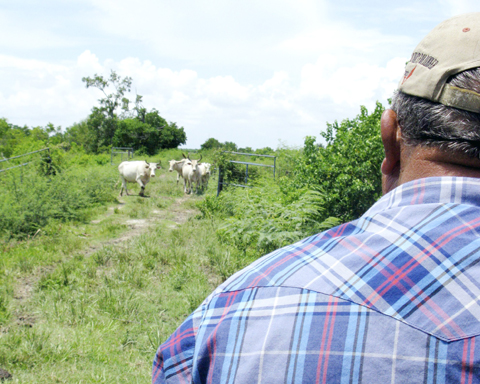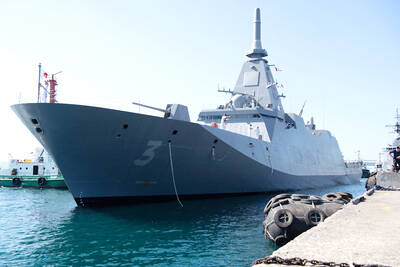The cattle in these parts don’t seem to mind the helicopters hauling oil booms overhead, nor the response boats hurrying past their banks.
However, the oil that British energy giant BP is scrambling to clean up from its massive Gulf of Mexico spill threatens the animals’ grazing land and the income of the ranchers who own them.
More than 1,000 head of cattle graze on marshy islands off Louisiana’s southeast tip and thousands more are found in the coastal low-lying pastures highly susceptible to flooding.

PHOTO: REUTERS
The petroleum and cattle industries have managed to co-exist over the years, but now, ranchers fear a hurricane in this watery southeastern area of the state could wash the oil onto grazing land, poisoning their livestock and ruining their value.
“We don’t have a clue what this oil will do,” said Robert Joyner, who heads the Louisiana Cattlemen’s Association. “It’s a whole ’nother ball game.”
Louisiana is home to about 450,000 head of cattle valued last year at US$365 million, but the best pasture land is in the coastal south, where cattle can graze year-round.
Even before the oil spill, it was a challenge being a cattleman here, where many animals can only be moved by barge. Calves succumb to alligators and snake bites, corrals need constant maintenance amid the quick-growing vegetation, and erosion and rising water levels steal valuable pasture every year. And then there are the hurricanes.
Hurricane Katrina in 2005 killed 1,800 of Earl Armstrong’s cattle. The next hurricane could pack a double wallop, with the additional danger of toxins brought ashore.
“I’m not being happy with the oil right now,” said Armstrong, whose cattle graze at the mouth of the Mississippi River, not far from the oil spill clean-up’s command center. “I don’t know when it’s going to come in on that cattle where they have to eat that grass. It’s a wait-and-see deal.”
Ranchers see themselves ending up last on BP’s compensation list after the oystermen, shrimpers and others who have lost their livelihoods because of the spill are taken care of under BP’s US$20 billion fund.
“They want to know if there is a state or federal program to reimburse them for the losses and the answer now is no,” said Mike Strain, the state’s commissioner of agriculture and forestry.
Early this month, Strain’s agency warned coastal cattle producers that their livestock would not be allowed to go to slaughter if oil contaminates inland pastures.
The US Department of Agriculture’s Food Safety and Inspection Service (FSIS) is estimating exposure levels to dangerous chemicals if oil washes ashore and identifying appropriate tests, FSIS spokesman Brian Mabry said.
The average cow here is worth about US$1,000, but it would cost about double that to transport and incinerate any deemed unfit for the food supply chain, Strain said.
That means ranchers are scrambling to plan for a sudden evacuation of cattle ahead of a hurricane.
Cattle ranchers from areas unaffected by a hurricane have volunteered to bring trucks and trailers to help in transport, Joyner said, but finding a place to put the relocated cattle is one of a number of problems to be dealt with.
However, cattlemen here are loath to transport their animals unnecessarily, given the difficult logistics and stress to the animals.
“Daddy’s here, boys!” shouts Philip Simmons from his flatboat on the Mississippi, catching a glimpse of two of his Brangus bulls grazing the native grasses at water’s edge.
Simmons’ family has been grazing cattle for generations on land that’s surrounded by backwater canals, natural bayous and the Mississippi, a watery oasis of mangroves and willows and wildlife like cranes and spoonbills.
“My cattle feed all the way to the water here,” he said, pointing to the bank of a winding canal, where one group gazed out quizzically from under a canopy of trees and high grasses.
“How am I going to get them out,” Simmons said. “You’d have to get a helicopter to run them out of this grass. And it’s so hot it’ll kill them. So I’m just playing it by ear. Hopefully I’ll come out on the winning end.”

Eleven people, including a former minister, were arrested in Serbia on Friday over a train station disaster in which 16 people died. The concrete canopy of the newly renovated station in the northern city of Novi Sad collapsed on Nov. 1, 2024 in a disaster widely blamed on corruption and poor oversight. It sparked a wave of student-led protests and led to the resignation of then-Serbian prime minister Milos Vucevic and the fall of his government. The public prosecutor’s office in Novi Sad opened an investigation into the accident and deaths. In February, the public prosecutor’s office for organized crime opened another probe into

RISING RACISM: A Japanese group called on China to assure safety in the country, while the Chinese embassy in Tokyo urged action against a ‘surge in xenophobia’ A Japanese woman living in China was attacked and injured by a man in a subway station in Suzhou, China, Japanese media said, hours after two Chinese men were seriously injured in violence in Tokyo. The attacks on Thursday raised concern about xenophobic sentiment in China and Japan that have been blamed for assaults in both countries. It was the third attack involving Japanese living in China since last year. In the two previous cases in China, Chinese authorities have insisted they were isolated incidents. Japanese broadcaster NHK did not identify the woman injured in Suzhou by name, but, citing the Japanese

YELLOW SHIRTS: Many protesters were associated with pro-royalist groups that had previously supported the ouster of Paetongtarn’s father, Thaksin, in 2006 Protesters rallied on Saturday in the Thai capital to demand the resignation of court-suspended Thai Prime Minister Paetongtarn Shinawatra and in support of the armed forces following a violent border dispute with Cambodia that killed more than three dozen people and displaced more than 260,000. Gathered at Bangkok’s Victory Monument despite soaring temperatures, many sang patriotic songs and listened to speeches denouncing Paetongtarn and her father, former Thai prime minister Thaksin Shinawatra, and voiced their backing of the country’s army, which has always retained substantial power in the Southeast Asian country. Police said there were about 2,000 protesters by mid-afternoon, although

MOGAMI-CLASS FRIGATES: The deal is a ‘big step toward elevating national security cooperation with Australia, which is our special strategic partner,’ a Japanese official said Australia is to upgrade its navy with 11 Mogami-class frigates built by Japan’s Mitsubishi Heavy Industries, Australian Minister for Defence Richard Marles said yesterday. Billed as Japan’s biggest defense export deal since World War II, Australia is to pay US$6 billion over the next 10 years to acquire the fleet of stealth frigates. Australia is in the midst of a major military restructure, bolstering its navy with long-range firepower in an effort to deter China. It is striving to expand its fleet of major warships from 11 to 26 over the next decade. “This is clearly the biggest defense-industry agreement that has ever